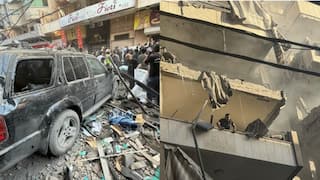Blinding Fog, Plummeting Temperature — Another Zero-Visibility Day In Delhi Amid Intense Cold Wave
Delhi-NCR Weather: Delhi and the NCR are experiencing a severe cold wave with dense fog, causing zero visibility. The region is likely to experience rain as well in the next two days.

Delhi Weather Today: Dense fog has again blinded Delhi-NCR. On Friday morning, the visibility was back to zero in Delhi, Noida, Ghaziabad, Gurgaon, and other nearby regions. The impact of the fog was seen on the early morning traffic as motorists slowed down. Even driving with their vehicle lights on helped little to improve visibility.
WATCH | दिल्ली-NCR में छाया घना कोहरा, कई इलाकों में विजिबिलिटी हुई जीरो @anchorjiya | @aparna_journo https://t.co/smwhXUROiK #Fog #Delhi #NCR #Indiagate #Winters pic.twitter.com/o6LzWoc46j
— ABP News (@ABPNews) January 10, 2025
The India Meteorological Department (IMD) has issued an orange alert for Delhi, cautioning that dense to very dense fog is likely to prevail throughout Friday. Motorists are advised to use fog lights while driving. People planning to travel by train or flights have been advised to get in touch with their airlines or the Railways to get the latest updates on delays and cancellations.
An IMD warning on Friday stated: "Dense to very dense fog at a few places over Punjab, Haryana and isolated places over Uttar Pradesh and Dense fog at isolated places over Himachal Pradesh. Cold wave conditions at isolated places over Jammu &Kashmir, Himachal Pradesh and Punjab."
Visibility reduced to zero as a blanket of dense fog witnessed in parts of Delhi-NCR#Delhi #Fog #WINTER pic.twitter.com/7Db6x697hC
— DD News (@DDNewslive) January 10, 2025
Delhi-NCR Temperature Plummets
The minimum temperature is expected to drop to 6 degrees Celsius and the maximum temperature is likely to hover around 20 degrees Celsius. Trouble for Delhi is likely to mount as the IMD has forecast rain and dense fog on January 11 and 12. The dense fog cover is likely to persist till January 15. The maximum temperature is likely to drop from 20 degrees Celsius to 18 degrees Celsius over the next few days.
Watch: Delhi engulfed in dense fog, Vasant Kunj area of the Southwest District experienced thick fog early morning pic.twitter.com/alntBlXtNA
— IANS (@ians_india) January 10, 2025
After cold winds and dense fog in Delhi for several days, the sun was visible on Thursday and the maximum temperature was recorded at 21.2 degrees Celsius, which was 2.2 degrees above normal. The sky remained clear during the day in Delhi and there was light fog in the morning. According to the IMD, the humidity was 87%.
However, Thursday morning was very cold and the minimum temperature was recorded at 4.8 degrees Celsius, while on Wednesday it was 7.4 degrees Celsius.
VIDEO | Dense fog engulfs Delhi reducing visibility to zero. Visuals from Mayur Vihar Extension.
— Press Trust of India (@PTI_News) January 10, 2025
(Full video available on PTI Videos - https://t.co/n147TvqRQz) pic.twitter.com/njq4LMIGKr
GRAP-3 Restrictions Back
Due to adverse weather conditions, the Centre's panel on air quality re-imposed restrictions under the third stage of the Graded Response Action Plan (GRAP) in the Delhi-NCR (National Capital Region) due to a sharp rise in air pollution levels.
Air pollution levels in Delhi have been rising and the 24-hour average Air Quality Index (AQI) reached 357 by 4 PM on Thursday due to slow winds and fog, which was 297 on Wednesday.
VIDEO | Thick layer of fog blankets Delhi and surrounding areas amid intense cold conditions in the region. Visuals from Dhaula Kuan area.#WeatherUpdate #DelhiWeather
— Press Trust of India (@PTI_News) January 10, 2025
(Full video available on PTI Videos - https://t.co/n147TvqRQz) pic.twitter.com/1n2lKcdMKT
The Commission for Air Quality Management (CAQM), which is responsible for formulating strategies to reduce air pollution levels in Delhi-NCR, has directed the authorities of the region to immediately implement the pollution control measures prescribed under the third stage of GRAP to prevent the situation from worsening.
An AQI between 0 and 50 is considered ‘good’, between 51 and 100 is ‘satisfactory’, between 101 and 200 is ‘moderate’, between 201 and 300 is ‘poor’, between 301 and 400 is ‘very poor’ and between 401 and 500 is ‘severe’.







































